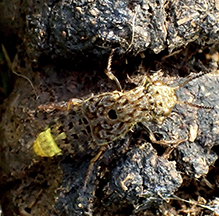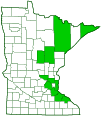gold-and-brown rove beetle
(Ontholestes cingulatus)
Conservation • Description • Habitat • Ecology • Distribution • Taxonomy
Conservation Status |
|
|||||||
| IUCN Red List | not listed |
|||||||
| NatureServe | NNR - Unranked |
|||||||
| Minnesota | not listed |
|||||||
Description |
||
Gold-and-brown rove beetle is a medium-sized beetle but a large rove beetle. It occurs throughout the United States and southern Canada. In the U.S. it occurs from Maine to North Carolina, west to Minnesota and Arkansas, and in the Pacific Northwest, with just a few scattered records outside of these ranges. It is found from May to October in almost every terrestrial habitat, including woodlands, fields, and compost piles. Adults prey on flies and are seen mostly on carrion and dung but also on other decaying organic material, including fungi, fruit, and vegetables. Adults are usually ½″ to 11⁄16″ (13 to 18 mm) in length but may be up to 13⁄16″ (21 mm) in length. The body is robust, long, and nearly parallel sided. It is brown with small patches of dense, dark hairs (setae). The head is as wide as the thorax and is densely pitted (punctate). The eyes are large. The antennae have 11 segments. They are short, slender, and bicolored. The basal half of each antenna is yellowish, the outer half is black. The exoskeletal plate on the upper side of the thorax (pronotum) is as wide as long, widest in front, and slightly tapered to the rear. The front corners of the pronotum are extended, angled forward, and sharply pointed. The surface is densely and finely punctate. On the underside the last segment of the thorax is covered with bright golden-yellow setae. The abdomen is flexible. The tip of the abdomen is densely covered with bright golden-yellow setae. These hairs are iridescent, appearing to glow at some angles, like the bioluminescence of fireflies. The hardened wing covers (elytra) are slightly wider than the pronotum. They are short, exposing 5 or 6 abdominal segments. The surface is rough due to a covering of fine granules. The legs are bicolored. The third segment (femur) of each leg is mostly dark brown to black. The tip of the femur and remainder of the leg are paler and yellowish. The last part of each leg (tarsus), corresponding to the foot, has 5 segments. |
||
Size |
||
Total length: ½″ to 11⁄16″ (13 to 18 mm) |
||
Similar Species |
||
Habitat |
||
Almost every terrestrial habitat, including woodlands, fields, and compost piles |
||
Ecology |
||
Season |
||
May to October (CCESR) |
||
Behavior |
||
The adult is a strong flier. It is difficult to photograph because it will quickly fly away when it detects movement. When threatened, it will raise the tip of its abdomen to contact the threat and release a chemical defense. |
||
Life Cycle |
||
After mating, the male will guard the female while she deposits her eggs, preventing other males from mating with her. |
||
Larva Food |
||
|
||
Adult Food |
||
Flies |
||
Distribution |
||||
|
Sources |
|||
| 5/4/2023 | ||||
Occurrence |
||||
Common |
||||
Taxonomy |
|||
Order |
Coleoptera (Beetles) | ||
Suborder |
Polyphaga (Water, Rove, Scarab, Long-horned, Leaf, and Snout Beetles) | ||
Infraorder |
Staphyliniformia | ||
Superfamily |
Staphylinoidea (rove, ant-like stone, and carrion beetles) | ||
Family |
Staphylinidae (rove beetles) | ||
Subfamily |
Staphylininae (large rove beetles) | ||
Tribe |
Staphylinini | ||
| Subtribe | Staphylinina | ||
Genus |
Ontholestes | ||
Synonyms |
|||
|
|||
Common Names |
|||
gold-and-brown rove beetle gold-brown rove beetle |
|||
Glossary
Elytra
The hardened or leathery forewings of beetles used to protect the fragile hindwings, which are used for flying. Singular: elytron.
Femur
On insects and arachnids, the third, largest, most robust segment of the leg, coming immediately before the tibia. On humans, the thigh bone.
Pronotum
The exoskeletal plate on the upper side of the first segment of the thorax of an insect.
Punctate
Dotted with pits (punctures), translucent sunken glands, or colored spots of pigment.
Seta
A stiff, hair-like process on the outer surface of an organism. In Lepidoptera: A usually rigid bristle- or hair-like outgrowth used to sense touch. In mosses: The stalk supporting a spore-bearing capsule and supplying it with nutrients. Plural: setae. Adjective: setose.
Tarsus
On insects, the last two to five subdivisions of the leg, attached to the tibia; the foot. On spiders, the last segment of the leg. Plural: tarsi.
Visitor Photos |
|||||
Share your photo of this insect. |
|||||
| This button not working for you? Simply email us at info@MinnesotaSeasons.com. Attach one or more photos and, if you like, a caption. |
|||||
Babette Kis |
|||||
Ontholestes cingulatus gold and brown rove beetle … on dog poop |
 |
||||
MinnesotaSeasons.com Photos |
|||||
|
|||||

Slideshows |
||

Visitor Videos |
|||
Share your video of this insect. |
|||
| This button not working for you? Simply email us at info@MinnesotaSeasons.com. Attach a video, a YouTube link, or a cloud storage link. |
|||
Other Videos |
|||
| Beetles on Raccoon Carcass Timothy Johnston |
|||
About
Aug 7, 2019 Four species of beetles on a raccoon carcass: Creophilus maxillosus, Oiceoptoma novaboracense, Ontholestes cingulatus, Necrodes surinamensis |
|||
| Gold and brown Rove beetle Lori Jackson |
|||
About
Jul 27, 2020 Was with carrion beetle's on poo |
|||

Created: 5/4/2023
Last Updated:


